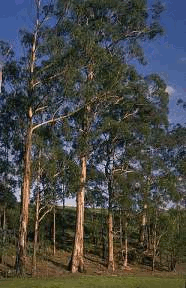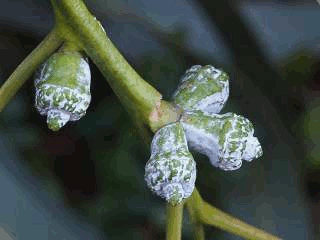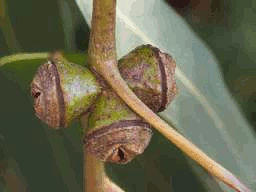Eucalyptus
 Common Names: Eucalyptus, eurabbie, blue gum, Southern blue gum, Tasmanian blue gum
Common Names: Eucalyptus, eurabbie, blue gum, Southern blue gum, Tasmanian blue gum
Scientific Name: Eucalyptus globulus
Climate: Mild temperate, cool highland.
Plant Description: Eucalyptus globulus is a large evergreen tree with a narrow crown that becomes rounded for trees growing in the open. They typically grow from 30–55 m. The tree has a massive straight trunk which can reach to 2 m in diameter with narrow, irregular crown of large branches. These are characterized by dropping and aromatic foliage. Leaves alternate, drooping on flattened yellowish petioles long. The leaves are sickle-shaped with visible oil glands that look like tiny dots on the leaf surface. They are mostly curved, thick, leathery, and shiny dark green. The plants bear their flowers in groups, or inflorescences, that always include an odd number of flowers (1, 3, 5, 7 and 11). Each flower bud has a cap made up of the petals and sepals. This cap is lost when the flower opens. The stamens are numerous and are arranged in four bunches or in a continuous ring. The fruit is a woody capsule, a type of dry fruit that opens when mature to release the seeds. The capsule opens by valves. The bark is smooth, mottled, gray brown, and greenish or bluish, it peels in long strips. Root system is deep and spreading.
It is native to Australia and Tasmania. Tasmanian blue gum is the most widely planted eucalyptus species in the world with a total of 800,000 ha in dozens of countries.
Cultivation: Full sun. It cannot grow in the shade. Plants should not be grown in windy and cold sites. It grows best in a temperature range of 16 to 20°C. Can support night frosts no below -5°C. Adjust to all types of soil - sandy, loamy and clay; prefers well-drained moist or wet soil and can grow in nutritionally poor earth. Can tolerate drought.
Propagation by seed - surface sow February/March in a sunny position in a greenhouse. For species that come from high altitudes it is better to give them 6 - 8 weeks of cold stratification at 2°C. Pot up the seedlings into individual pots as soon as the second set of seed leaves has developed, if left longer than this they might not move well. Use a 1 - 2 gallon container with potting mix with the appropriate amount of fertilizer with micronutrients
Keep moist. Plant out into their permanent positions in early summer and give them some protection from the cold in their first winter. The seed can also be sown in June, the young trees being planted in their final positions in late spring of the following year. The seed has a long viability.
If you want to plant Eucalyptus directly in the garden, prepare a spot for it. If your soil is clay-like or sandy, mix humus (compost) into the existing soil to improve its quality. Use a hoe or spade to break up existing soil, and pour the compost into the loosened soil; mix with a strong rake or hoe.
Note: The bark strips, leaves and branches that litter the floor of the eucalyptus grove contain chemicals that inhibit the growth of other plants. This litter is also flammable, and under some conditions can produce drifting burning materials. It is also considered an invasive species.
 Uses: The timber is used for carpentry, construction, fences, piles, platforms, plywood, poles, etc. Essential oil, used in cough drops, it is antimicrobial, antiseptic, rubefacient, and stimulant. The leaves have proven antibiotic activity. Due to their expectorant properties, the leaves are used for the treatment of respiratory problems such as bronchitis, sinusitis, tracheitis. Their decoction is used for repelling insects and vermin. Finely powdered bark is used as an insect dust. The tree itself is a good source of nectar and pollen for bees.
Uses: The timber is used for carpentry, construction, fences, piles, platforms, plywood, poles, etc. Essential oil, used in cough drops, it is antimicrobial, antiseptic, rubefacient, and stimulant. The leaves have proven antibiotic activity. Due to their expectorant properties, the leaves are used for the treatment of respiratory problems such as bronchitis, sinusitis, tracheitis. Their decoction is used for repelling insects and vermin. Finely powdered bark is used as an insect dust. The tree itself is a good source of nectar and pollen for bees.
Pests and Diseases: It is resistant to attack by insects or diseases. However the most common are: Eucalyptus tortoise beetles (Trachymela sloanei ), The bronze bug (Thaumastocoris peregrinus), Black mildew, Cryptosporiopsis leaf and shoot blight. Cylindrocladium foliar spot and foliar blight. Mycosphaerella leaf diseases Phaeophleospora. Web blight, powdery mildew, eucalyptus rust.
References:
N.A.S. 1980a. Firewood crops. Shrub and tree species for energy production. National Academy of Sciences, Washington, DC.
http://bhort.bh.cornell.edu/histology/ffossils/eucalypt.html
Huxley. A. The New RHS Dictionary of Gardening. 1992. MacMillan Press 1992 ISBN 0-333-47494-5
Morton, J.F. 1981. Atlas of medicinal plants of middle America. Bahamas to Yucatan. C.C. Thomas, Springfield, IL
http://www.patologiaforestal.com/descargas/Enfermedades%20en%20Eucalipto.pdf
En Espanol: Eucalipto
